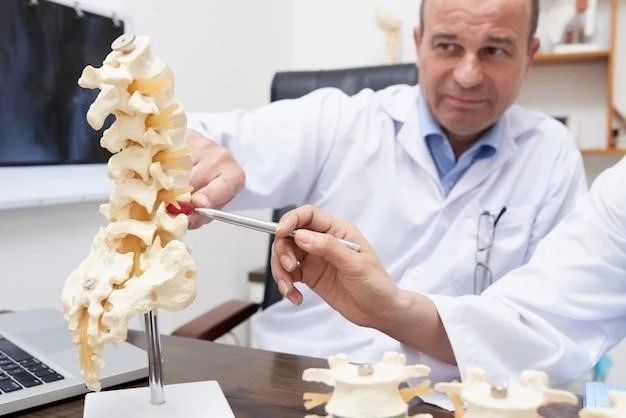Axial osteomalacia can be caused by various factors, including vitamin D deficiency, inadequate calcium intake, certain chronic diseases affecting bone metabolism, and genetic disorders affecting mineralization processes.
Symptoms of axial osteomalacia may include bone pain, muscle weakness, difficulty walking, increased risk of fractures, and skeletal deformities due to weakened bones.
Diagnosis of axial osteomalacia involves blood tests to assess vitamin D levels, imaging studies such as X-rays and bone scans, and sometimes a bone biopsy to evaluate bone mineralization.
Treatment for axial osteomalacia typically involves vitamin D and calcium supplements, lifestyle modifications, physical therapy, and in severe cases, medical interventions to improve bone health.
Preventive measures for axial osteomalacia include maintaining adequate vitamin D and calcium levels, following a balanced diet, regular sunlight exposure, and managing underlying conditions that may contribute to bone health issues.
Axial osteomalacia in children may lead to growth delays, skeletal abnormalities, and developmental issues. Early detection and appropriate interventions are crucial for optimal bone development.
Untreated axial osteomalacia can lead to complications such as increased risk of fractures, deformities, chronic pain, mobility issues, and decreased quality of life. Timely management is essential to prevent these complications.
Ongoing research in axial osteomalacia focuses on understanding the underlying mechanisms, developing targeted therapies, improving diagnostic tools, and exploring innovative approaches to enhance bone health and reduce the burden of this condition.
Introduction to Axial Osteomalacia
Axial osteomalacia is a metabolic bone disorder characterized by the softening of bones, particularly in the axial skeleton, which includes the spine and pelvis. This condition results from impaired mineralization of bone matrix, leading to weakened skeletal structures and increased susceptibility to fractures. Axial osteomalacia can significantly impact the individual’s quality of life, mobility, and overall health. Understanding the causes, symptoms, diagnosis, treatment options, preventive measures, and potential complications of axial osteomalacia is essential for effective management and care of individuals affected by this condition. Additionally, exploring research advancements in the field of axial osteomalacia is crucial for developing new insights, therapies, and interventions to improve outcomes for patients. This article aims to provide a comprehensive overview of axial osteomalacia, addressing key aspects from etiology to emerging trends in the management of this bone disorder.
Causes of Axial Osteomalacia

Axial osteomalacia can be attributed to various factors that disrupt the normal bone mineralization process. Common causes include inadequate intake or absorption of vitamin D, which is essential for calcium absorption and bone mineralization. Insufficient dietary calcium, phosphorus, or magnesium levels can also contribute to the development of axial osteomalacia. Additionally, certain chronic conditions such as chronic kidney disease, liver disorders, and malabsorption syndromes can impair the body’s ability to maintain proper mineral balance in the bones, leading to softening and weakness. Genetic disorders affecting mineral metabolism pathways, such as hypophosphatemic rickets, can also predispose individuals to axial osteomalacia. Identifying and addressing the underlying causes of axial osteomalacia is crucial for effective management and prevention of complications associated with this bone disorder.
Symptoms of Axial Osteomalacia
Individuals with axial osteomalacia may experience a range of symptoms related to bone weakening and mineralization issues in the axial skeleton. Common symptoms include persistent bone pain, especially in the lower back and hips, muscle weakness, leading to difficulties in walking or performing daily activities, and an increased risk of fractures from minor traumas or stress. Skeletal deformities, such as bowed legs or a curvature of the spine, can also manifest in severe cases of axial osteomalacia. Additionally, individuals may exhibit symptoms of fatigue, joint pain, and generalized weakness due to compromised bone health. Recognizing these signs and symptoms is crucial for early detection and timely intervention to prevent further complications associated with axial osteomalacia.
Diagnosis of Axial Osteomalacia
Diagnosing axial osteomalacia involves a comprehensive evaluation of medical history, physical examination, and diagnostic tests to assess bone health and mineralization. Blood tests to measure levels of vitamin D, calcium, phosphorus, and other minerals are essential in identifying deficiencies that may contribute to bone softening. Imaging studies, including X-rays, bone scans, and possibly magnetic resonance imaging (MRI), help visualize bone density and detect potential abnormalities. In some cases, a bone biopsy may be recommended to examine the bone tissue microscopically and assess mineralization patterns. These diagnostic procedures aid in confirming the presence of axial osteomalacia, determining the extent of bone damage, and guiding healthcare providers in formulating an appropriate treatment plan tailored to the individual’s specific needs.
Treatment Options for Axial Osteomalacia
Treating axial osteomalacia aims to address the underlying cause, improve bone mineralization, and prevent further complications. The primary treatment approach involves vitamin D supplements to correct deficiencies and enhance calcium absorption for bone health. Calcium and phosphorus supplements may also be prescribed to support mineralization processes. Lifestyle modifications, including adequate exposure to sunlight, balanced nutrition, and regular exercise, help promote overall bone strength and metabolic balance. Physical therapy can assist in improving muscle tone and enhancing mobility. In severe cases, medical interventions such as bisphosphonates or other medications to strengthen bones may be considered. Treatment plans are individualized based on the severity of symptoms, underlying conditions, and response to therapy. Regular monitoring and follow-up evaluations are crucial to track progress, adjust treatment regimens, and optimize outcomes for individuals with axial osteomalacia.
Prevention of Axial Osteomalacia
Preventing axial osteomalacia involves proactive measures to support optimal bone health and mineralization processes. Adequate intake of vitamin D through dietary sources or supplements is essential for maintaining calcium absorption and bone strength. Ensuring sufficient levels of calcium, phosphorus, and magnesium in the diet also plays a critical role in supporting bone mineralization. Regular exposure to sunlight, a natural source of vitamin D, contributes to bone health. Adopting a balanced diet rich in nutrients necessary for bone metabolism, such as dairy products, leafy greens, and fortified foods, can help prevent deficiencies that may lead to axial osteomalacia. Managing underlying conditions that affect bone health, such as kidney or liver disorders, through proper medical care and monitoring is crucial. Engaging in weight-bearing exercises and physical activities promotes bone density and overall musculoskeletal health. By incorporating these preventive strategies into daily routines, individuals can reduce the risk of developing axial osteomalacia and maintain strong and healthy bones throughout their lives.
Axial Osteomalacia in Children
Axial osteomalacia in children poses unique challenges due to the impact on growth and skeletal development. Vitamin D deficiency, nutritional imbalances, genetic disorders, or underlying medical conditions can contribute to the development of axial osteomalacia in pediatric patients. Children with this condition may experience delays in growth, bone deformities, and increased risk of fractures, which can affect their physical and emotional well-being. Early detection through clinical evaluation, laboratory tests, and imaging studies is crucial in children to initiate timely interventions. Treatment strategies typically include vitamin D supplementation, dietary adjustments, and monitoring bone health progression. Close monitoring by pediatric specialists is essential to ensure optimal growth and development while managing axial osteomalacia effectively in children. Addressing the specific needs of pediatric patients with axial osteomalacia is vital in providing comprehensive care and promoting long-term bone health.
Complications of Axial Osteomalacia
Untreated axial osteomalacia can lead to various complications that impact an individual’s musculoskeletal health and overall well-being; Prolonged softening of bones increases the risk of fractures, especially in weight-bearing areas such as the spine and hips, causing pain and limitations in mobility. Skeletal deformities, including bowed legs, kyphosis, or scoliosis, may develop due to weakened bone structures. Chronic pain, muscle weakness, and decreased physical function can significantly affect quality of life. In severe cases, complications such as osteoporosis, fractures that fail to heal properly, and neurological issues due to spinal deformities may arise. Timely diagnosis, appropriate treatment, and ongoing management are essential in preventing or alleviating these complications associated with axial osteomalacia, thereby preserving bone strength, function, and overall health.
Research Advancements in Axial Osteomalacia
Ongoing research in the field of axial osteomalacia is focused on expanding our understanding of the underlying mechanisms, exploring novel diagnostic tools, and developing targeted therapies to improve patient outcomes. Advances in genetic studies have identified potential gene mutations associated with osteomalacia, paving the way for tailored treatment approaches based on individual genetic profiles. Researchers are investigating the role of specific proteins and signaling pathways involved in bone mineralization to identify new targets for drug development. Moreover, studies exploring the interaction between vitamin D, calcium metabolism, and bone health aim to refine current treatment strategies and enhance patients’ responses to therapy. Collaborative efforts among clinicians, scientists, and pharmaceutical companies have the potential to bring about innovative solutions for managing axial osteomalacia and reducing the burden of this debilitating bone disorder.
